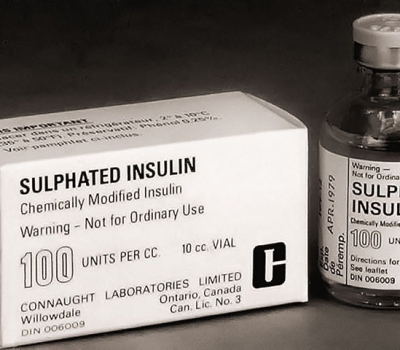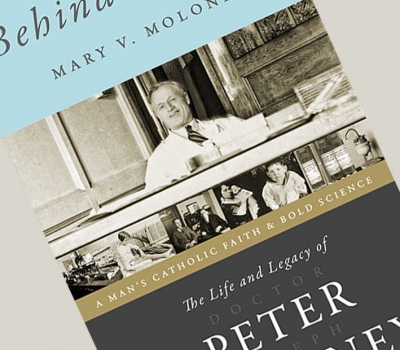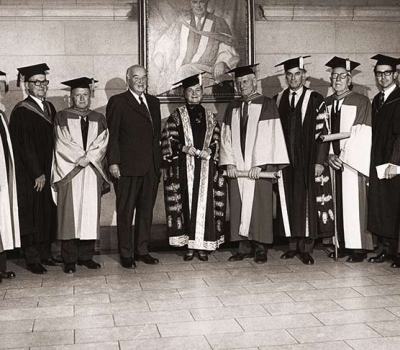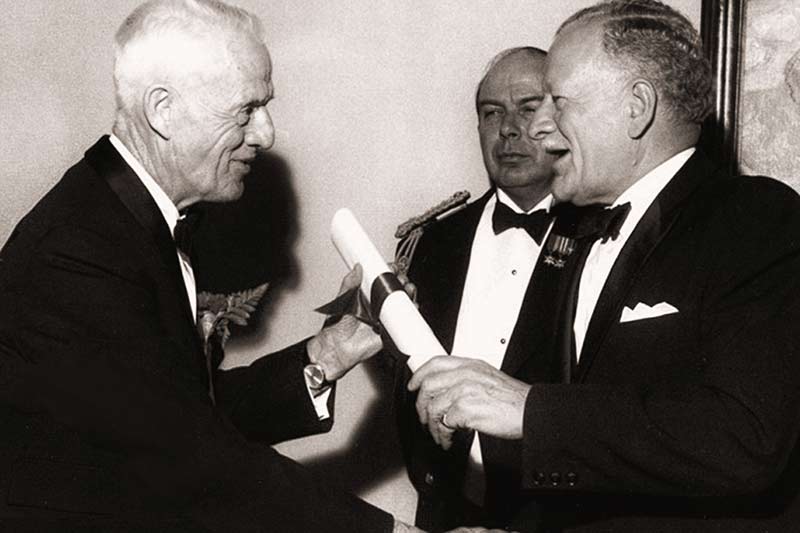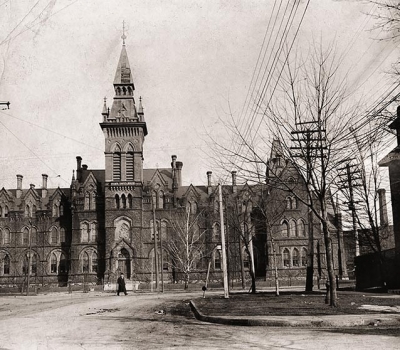Catholic Perspectives on Faith and Science: Visit
Unapologetic Catholic Science | Visit
Science.ca | Dr. Peter Moloney
Although Banting and Best discovered insulin, they did not have the know-how to purify it. This was done haphazardly by one man, who could not reproduce his first success, which greatly annoyed Dr. John Gerald Fitzgerald. It was Dr. Peter Joseph Moloney who successfully purified insulin from benzoic acid, a technique he brought to the Toronto lab from his earlier work. He was the one who made the first pure, safe preparation for the world market, thus securing fame for Banting and Best. He was also the one, told by Fitzgerald, to "drop everything and start producing diphtheria toxoid", a very dangerous procedure, who gave North America and eventually the world, diphtheria toxoid, first discovered by Gaston Ramon in France. He also invented the quick acting pH electrode. He won the Gairdner Award, and many more awards, including the Order of the British Empire for producing a gas gangrene antiserum during the second World War.
Reflections of a Catholic Scientist | Are All Great Scientists Atheists?
- Professor Christian Anfinsen* (Nobel Prize for Chemistry, biochemistry of RNA, Johns Hopkins University): "I think that only an idiot can be an atheist! We must admit that there exists and incomprehensible power or force with limitless foresight and knowledge that started the whole universe going in the first place."
- Professor Werner Archer (Nobel Prize for Physiology/Medicine, restriction enzymes and molecular genetics, University of Basel): "I do not think our civilization has succeeded in discovering and explaining all the principles acting in the universe. I include the concept of God among these principles. I am happy to accept the concept without trying to define it precisely. I know that the concept of God helped me to master many questions in life; it guides me in critical situations and I see it confirmed in many deep insights into the beauty of the functioning of the living world."
- Professor D.H.R. Barton*** (Nobel Prize for Chemistry, conformational analysis in organic chemistry, Texas A&M University): "God is Truth. There is no incompatibility between science and religion. Both are seeking the same truth"
- Professor Ulrich Becker** (High energy particle physics, MIT): "How can I exist without a creator? I am not aware of any answer ever given."
- Professor Steven Bernasek (Solid state chemistry, Princeton University): "I believe in the existence of God. His existence is apparent to me in everything around me, especially in my work as a scientist. On the other hand I cannot prove the existence of God the way I might prove or disprove a (scientific) hypothesis."
Canadian Public HEalth Association | Distinuished Scientist, Teacher and Vaccine Developer
Dr. Peter J. Moloney earned an MA in Chemistry from the University of Toronto, was engaged in the Food Laboratory of the Department of Agriculture in Ottawa and in 1919, was appointed research chemist in the Connaught Laboratories. His first studies were of diphtheria toxin and after receiving his PhD in 1921, began work on the purification of insulin for its clinical use. Dr. Moloney was given the responsibility of preparing the diphtheria toxoid for Connaught Laboratories in 1924, making is early use possible in Canada. He was Assistant Director of Connaught until 1955 and contributed to the development of the so-called “reaction test” for diphtheria toxoid. In studies with tetanus toxoid, he developed methods for its assay and purification and elucidated its antigenic constituents. Dr. Moloney was also one of a team that successfully devised methods for the preparation of penicillin during World War II—an urgency and complex challenge. Similarly, the call for a potent polyvalent gas gangrene antiserum was successfully met through the work of his colleagues and his own studies and at the close of the war, Dr. Moloney was honoured with the Order of the British Empire In 1931 he was appointed head of a newly established Chemistry in Relation to Hygiene department of the School of Hygiene, which provided courses of instruction for postgraduate students and for PhD candidates. He was elected a Fellow of the Royal Society of Canada in 1935 and was a member of the American Chemical Society, the Bio-chemical Societies of Canada and Great Britain and the Canadian Physiological Society. It is for his sterling character and his kindness that his students and friends across Canada speak of his name with gratitude. Dr. Peter J. Moloney was awarded CPHA’s Honorary Life Membership in 1962.
(Canadian Journal of Public Health, Vol. 53, June 1962)
Other: Bio-Medical Research Links
The Banting and Best Department of Medical Research (UofToronto) | Visit
The discovery of insulin was one of the most important medical achievements of the twentieth century, netting Frederick Banting and James MacLeod the Nobel Prize in Medicine in 1923, and bringing worldwide acclaim to co-discoverers Charles Best and James Collip. Prior to the discovery of insulin there was no way to treat diabetics. Today, the lives of millions worldwide are saved through the use of this hormone.
Dr. John FitzGerald | Visit
Personal friend of Dr. Peter Moloney and lead at Cannought Labs Toronto during the drive to develop anti-toxins.
Insulin: Discovery and Controversy | Visit
During the first two decades of the 20th century, several investigatorsprepared extracts of pancreas that were often successful inlowering blood sugar and reducing glycosuria in test animals.However, they were unable to remove impurities, and toxic reactionsprevented its use in humans with diabetes. In the spring of1921, Frederick G. Banting, a young Ontario orthopedic surgeon,was given laboratory space by J.J.R. Macleod, the head of physiologyat the University of Toronto, to investigate the function ofthe pancreatic islets. A student assistant, Charles Best, andan allotment of dogs were provided to test Banting’s hypothesisthat ligation of the pancreatic ducts before extraction of thepancreas, destroys the enzyme-secreting parts, whereas the isletsof Langerhans, which were believed to produce an internal secretionregulating sugar metabolism, remained intact. He believed thatearlier failures were attributable to the destructive actionof trypsin. The name "insuline" had been introduced in 1909for this hypothetic substance. Their experiments produced anextract of pancreas that reduced the hyperglycemia and glycosuriain dogs made diabetic by the removal of their pancreases. Theynext developed a procedure for extraction from the entire pancreaswithout the need for duct ligation. This extract, now made fromwhole beef pancreas, was successful for treating humans withdiabetes. Facilitating their success was a development in clinicalchemistry that allowed blood sugar to be frequently and accuratelydetermined in small volumes of blood. Success with purificationwas largely the work of J.B. Collip. Yield and standardizationwere improved by cooperation with Eli Lilly and Company. Whenthe Nobel Prize was awarded to Banting and Macleod for the discoveryof insulin, it aggravated the contentious relationship thathad developed between them during the course of the investigation.Banting was outraged that Macleod and not Best had been selected,and he briefly threatened to refuse the award. He immediatelyannounced that he was giving one-half of his share of the prizemoney to Best and publicly acknowledged Best’s contributionto the discovery of insulin. Macleod followed suit and gaveone-half of his money award to Collip. Years later, the officialhistory of the Nobel Committee admitted that Best should havebeen awarded a share of the prize.
Hailed as one of the most dramatic events in the history of the treatment of disease, the discovery of insulin at the University of Toronto in 1921–1922 extended the life-span of diabetic patients and made Fred Banting an international celebrity.

